Occupational Environment Monitoring at Electric Rice Cooker Manufacturing Factory
99,000 ₫
Note: The above price is calculated per sample and may vary depending on the area of the environment to be monitored and market fluctuations. For more accurate pricing support, please refer to the price list or contact our consulting staff directly.
Monitoring the environment of a electric rice cooker production factory is a session for collecting, analyzing, and evaluating workplace factors that may be harmful to workers’ health.
Table of Contents
Toggle1. Overview of Electric Rice Cooker Manufacturing Factory
a. What is a electric rice cooker manufacturing factory?
A manufacturing factory for electric rice cookers is an industrial facility specifically dedicated to producing and assembling various types of electric rice cookers. In this factory, production and processing processes are carried out to produce electric rice cookers in large quantities with high quality.
Electric rice cooker manufacturing factories typically have specialized areas and workrooms such as production areas, processing areas, assembly areas, quality control areas, and storage warehouses. Modern production lines and machinery are used to carry out different stages of production and processing in the electric cooker manufacturing process.

b. Production stages in a electric rice cooker manufacturing factory
The production stages in a electric rice cooker manufacturing factory may include:
- Processing the electric rice cooker casing: Shaping and processing the outer casing components of the electric rice cooker from materials such as stainless steel or composite plastic.
- Processing the electric rice cooker parts: Processing internal components of the rice cooker such as the cooking pot, control circuit, control panel, lid, and other components.
- Assembly: Assembling processed components into fully functional electric rice cookers. Assembly steps may include attaching the lid, installing the control circuit, attaching the control panel, and checking functionality.
- Quality inspection: Checking the quality and performance of electric rice cookers to ensure compliance with standards and quality requirements.
- Packing and warehousing: Packaging electric rice cookers and preparing them for storage and transportation to retail points or end customers.

c. Types of machinery used in a electric rice cooker manufacturing factory
In a electric rice cooker manufacturing factory, various machines and equipment are used to carry out production and processing stages. Here are some common machines used:
- Metal sheet cutting and bending machine: Used to cut and bend metal sheets such as stainless steel to form electric rice cooker casing components.
- Lathe machine: Used for machining metal parts of the electric rice cooker such as lids, water containers, steam tubes, etc.
- Plastic molding machine: Used for manufacturing plastic parts of the electric rice cooker such as control panels and insulation components.
- Extrusion machine: Used to process plastic parts like lids, water containers, etc.
- Welding machine: Used to weld metal components of the electric rice cooker such as metal sheets and other parts together.
- Stamping machine: Used for casting and shaping metal parts such as handles and feet.
- CNC machine: Used for precise machining of metal and plastic components of electric rice cookers.
- PCB pressing machine: Used for assembling and pressing control and electronic circuit boards in electric rice cookers.
- Quality control and inspection machines: Including function testing machines, dimensional measuring machines, pressure testing machines, and electronic testing machines to ensure product quality.
- Packing machine: Used for packaging and boxing electric rice cookers.

d. Occupational diseases that may occur among workers in electric rice cooker factories
Workers in electric rice cooker manufacturing factories may encounter the following occupational diseases:
- Respiratory diseases: Exposure to metal dust, wood dust, or metal fumes during processing and welding may lead to bronchitis, asthma, pneumonia, or increased risk of lung cancer.
- Skin diseases: Contact with chemicals during production may cause skin irritation, eczema, dermatitis, rashes, or infections.
- Nervous system disorders: Factors such as noise, vibrations, and high work pressure may cause stress, insomnia, psychological disorders, and nerve damage due to continuous exposure in the work environment.
- Hearing disorders: High noise levels from machinery and equipment during production may damage hearing, causing hearing loss, tinnitus, and ear pain.
- Spinal and musculoskeletal disorders: Continuous work in improper postures or lifting heavy objects may cause spinal injuries, arthritis, and back pain.
To protect workers’ health, personal protective measures and safe working procedures should be applied, including using protective equipment, controlling dust and chemicals, providing occupational safety training, and ensuring safe use of machinery.

e. Popular types of electric rice cookers on the market
There are many popular types of electric rice cookers on the market with different features and technologies. Here are some common types:
- Conventional electric rice cookers: Basic cookers with two functions: cooking and keeping warm. Simple and affordable.
- Smart electric rice cookers: Equipped with smart technology and multiple cooking modes. Can adjust temperature, cooking time, and cooking methods according to electric rice type.
- Multi-function electric rice cookers: Can perform various cooking functions such as porridge, steaming, braising, soups, and yogurt. Can also serve as slow cookers or pressure cookers.
- Premium electric rice cookers: Made of high-quality materials like stainless steel, with elegant design and advanced features such as touchscreen, mobile app control, automatic cooking modes, and moisture preservation.
- Mini electric rice cookers: Compact version suitable for small families, travel, or personal use. Small capacity and easy to carry.
- Multi-compartment electric rice cookers: Designed with multiple compartments to cook different dishes simultaneously, saving time and energy.

2. Overview of Occupational Environment Monitoring Services
a. What is occupational environment monitoring in a electric rice cooker manufacturing factory?
Occupational environment monitoring (or labor environment measurement) in a electric rice cooker manufacturing factory involves collecting, evaluating, and analyzing measured indicators of workplace environmental factors in order to take timely actions, minimize environmental hazards to workers’ health, and prevent occupational diseases. Occupational environment monitoring is a mandatory requirement for electric rice cooker manufacturing factories.
Occupational environment monitoring plays a crucial role in caring for, protecting, and improving workers’ health because employees are the primary workforce of a business and directly generate profit. Workers who are regularly exposed to occupational hazards exceeding permissible limits may experience health issues and develop occupational diseases.
REGISTER FOR OCCUPATIONAL ENVIRONMENT MONITORING SERVICE
b. Nam Viet occupational environment monitoring program
Nam Viet’s occupational environment monitoring program is developed by engineers specializing in occupational safety and environmental protection. Aiming to ensure workers’ health and safety, the program uses modern measurement methods to monitor air quality, water, microclimate, physical factors, dust, and more in the workplace. This program is essential to ensure a safe working environment and protect workers’ health.
Additionally, Nam Viet’s program plays an important role in researching and developing new solutions to improve workplace environmental quality. With the dedication and professionalism of the monitoring experts, Nam Viet’s exclusive monitoring program has become a breakthrough in occupational safety management and environmental protection in Vietnam.

c. Standardization in workplace measurement processes
Standardization in Nam Viet’s workplace measurement process is crucial for ensuring the accuracy and reliability of results. To ensure precise and reliable measurements, the program follows recognized standards and procedures from the Ho Chi Minh City Department of Health. This ensures collected data is highly reliable for evaluating the work environment and making decisions to improve it for workers’ health protection.
These standardized procedures also ensure that measurements are performed by a highly qualified team of monitoring specialists with years of experience, allowing managers and experts to trust Nam Viet’s results and make precise decisions that protect workers’ health and the environment.
By applying standardized measurement processes, Nam Viet demonstrates its commitment to ensuring a safe working environment and protecting workers’ health, while contributing positively to the development and improvement of occupational safety and environmental management in Vietnam.
d. Reporting occupational environment monitoring results in electric rice cooker factories
Monitoring results are compiled according to Form No. 04, Appendix III issued with Decree 44/2016/ND-CP and prepared in two copies: one copy is sent to the contracted workplace and one copy is kept by the monitoring organization.
The retention period for monitoring results follows legal regulations, with no expiration for storing records.

e. Frequency of occupational environment monitoring according to the law
According to Clause 2 of Article 18 of the Law on Occupational Safety and Hygiene 84/2015/QH13, employers must conduct occupational environment monitoring to assess harmful factors at least once a year.
f. Deadline for submitting monitoring results according to the law
The deadline for submitting reports is before December 31 each year. Enterprises operating production facilities are required to submit their occupational environment monitoring results to the local Department of Health where the main office is located and where workers are employed.
When there are changes in technology, production processes, or during renovation and upgrades that may generate new hazardous factors affecting workers’ health, enterprises must update occupational safety records regarding the harmful factors to be monitored.
g. Penalties for violations of occupational environment monitoring for employers
According to Article 27 of Decree No. 12/2022/ND-CP dated January 17, 2022, regulating administrative penalties in labor, social insurance, and Vietnamese workers working abroad under contract:
- Clause 2: A fine of 2,000,000 – 5,000,000 VND for employers who do not publicly disclose monitoring results and hazard assessments to workers at the workplace immediately after obtaining them.
- Clause 3: A fine of 20,000,000 – 40,000,000 VND for employers who fail to conduct occupational environment monitoring to control risks to workers’ health as required by law.
- Clause 4: A fine of 40,000,000 – 60,000,000 VND for employers who collude with monitoring organizations to falsify monitoring results without reaching criminal liability.
3. Harmful Environmental Factors for Workers in Electric Rice Cooker Manufacturing Factories
Workers in electric rice cooker manufacturing factories may be exposed to several harmful environmental factors. The following are potential hazards in the workplace of electric rice cooker factories:
- Metal dust and fumes: Metal processing and welding can generate metal dust and fumes, which can harm the respiratory and nervous systems. Long-term exposure to metal dust such as aluminum or stainless steel, or metal fumes such as lead or mercury, can lead to health problems including pneumonia, lung damage, and neurological damage.
- Noise: Machinery and equipment in the factory can generate high levels of noise. Continuous exposure can cause hearing issues, hearing loss, and other ear-related problems.
- Chemicals: Use of cleaning agents, additives, or other chemicals during production can cause skin irritation, allergic reactions, or respiratory issues if not used correctly or without proper protection.
- Temperature and humidity: Working conditions in the factory may involve fluctuating temperature and humidity, affecting workers’ health and comfort.
- Physical strain: Jobs in the factory may require lifting heavy objects or working in uncomfortable positions, causing muscle and skeletal stress and leading to spine and joint problems.
REGISTER FOR OCCUPATIONAL ENVIRONMENT MONITORING SERVICE
4. Measures to Improve the Working Environment in Electric Rice Cooker Manufacturing Factories
To improve the working environment and protect workers’ health, the following measures can be implemented:
- Ventilation and exhaust systems: Ensure proper ventilation to reduce humidity and circulate air. For production processes generating fumes or toxic gases, install efficient exhaust systems to remove them from the workspace.
- Electrical safety: Regularly inspect and maintain electrical systems to prevent fire, explosion, or electrical leakage.
- Use of protective equipment: Provide personal protective equipment such as helmets, safety glasses, gloves, and masks to ensure workers’ safety in hazardous environments.
- Training and education: Educate employees about occupational health and safety risks, including proper use of protective equipment, safe work procedures, and recognizing potential workplace hazards.
- Adjust work schedules: Review and adjust work hours, breaks, and workloads to reduce stress and fatigue.
- Temperature and humidity control: Maintain a comfortable working environment, adjusting air conditioning systems as needed.
- Chemical management: Ensure safe use of cleaning agents and other chemicals, following safety regulations. Provide guidance and protective measures to avoid direct exposure to harmful chemicals.
- Equipment inspection and maintenance: Regularly inspect, maintain, and repair machinery to ensure safety and operational efficiency.
- Periodic health check-ups: Conduct regular health examinations to detect work-related health issues early and provide preventive and corrective measures.
- Monitoring and compliance: Comply with safety, hygiene, and environmental regulations related to the electric rice cooker industry. Regularly monitor and evaluate compliance to improve the work environment.
- Periodically conduct occupational environment monitoring in factories to collect and analyze harmful factors, adjusting them to reduce hazards and prevent occupational diseases.
5. Benefits of Regular Monitoring in Electric Rice Cooker Manufacturing Factories
An Toan Nam Viet provides enterprises with great benefits when using occupational environment monitoring services in accordance with Decree 44/2016/ND – CP on managing and controlling harmful factors in the workplace affecting workers.
- Enterprises can proactively control harmful factors in workshops or factories.
- Receive advice and recommendations to minimize hazards and improve the workplace environment.
- Indirectly protect human resources, a key factor in business development.
- Reduce the impact of occupational diseases on workers’ health, lowering future treatment costs.
- Improved worker health ensures product quality and maintains production output.
- Ensure compliance with labor safety regulations, avoiding legal risks.
- Enhance credibility and professionalism, elevating the enterprise’s brand.
Nam Viet’s environmental monitoring service is a solution to reduce occupational disease risks, contributing to a clean and high-quality working environment.

6. Nationwide Occupational Environment Monitoring Center
Nam Viet Occupational Environment Monitoring Center is a professional unit specializing in monitoring and measuring occupational environment quality across all provinces in Viet Nam. With a team of experienced monitoring specialists, the center uses modern measurement equipment to ensure accuracy and reliability.
In addition to monitoring services, the center assists clients in planning, handling, and tracking occupational environment issues. Following the motto “customer-centric,” the center prioritizes client satisfaction, meets all client needs, and commits to providing the best solutions for enterprises.
REGISTER FOR OCCUPATIONAL ENVIRONMENT MONITORING SERVICE
With investment in technology, equipment, and personnel, Nam Viet’s monitoring center has become one of the most reputable units in occupational environment monitoring in Ho Chi Minh City, with the following objectives:
- We highly value our brand reputation and service quality.
- We provide clients with the best and most suitable solutions.
- With a team of experienced Masters and Engineers committed to environmental protection and benefiting enterprises.
- Clients using Nam Viet Environmental Monitoring receive professional service from experts along with the best cost advantages.
The occupational environment monitoring process at Nam Viet includes the following steps:
- Before monitoring, we ensure all equipment is calibrated and meets legal requirements.
- Follow the occupational environment monitoring procedures as committed to the Department of Health.
- Accurately report monitoring results to employers.
- If monitoring results indicate unsafe conditions for workers, Nam Viet will assist in corrective measures, and the enterprise will:
- Implement measures to improve working conditions and minimize harmful factor impacts, preventing occupational diseases.
- Organize health check-ups to detect occupational and related diseases early for workers in unsafe environments.
- Provide compensation in kind for workers according to labor law regulations.

7. Occupational Environment Monitoring Price List
To help enterprises conduct professional and effective occupational environment monitoring, Nam Viet provides clients with a detailed price list for monitoring services that is high-quality and reasonably priced.
- Our price list provides detailed information about monitoring service costs, including transportation, measurement, analysis, and report preparation. Clients can trust the accuracy and reliability of our monitoring reports.
- We commit to offering competitive and reasonable prices while providing prompt and professional consultation for any monitoring service inquiries.
- With Nam Viet’s price list, clients can easily select service packages that suit their needs, ensuring maximum satisfaction with professional service quality.
No comments yet

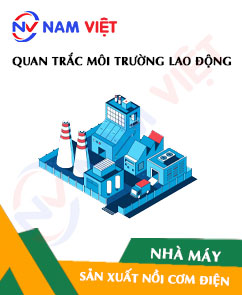
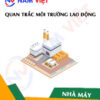
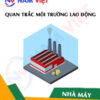
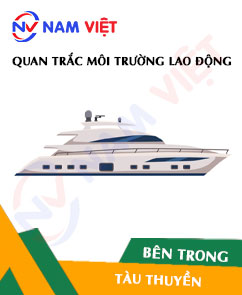




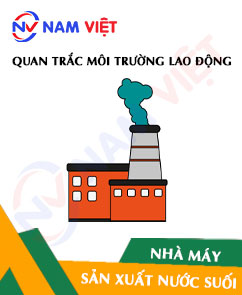

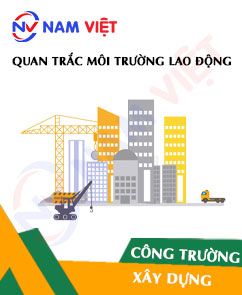
Review Occupational Environment Monitoring at Electric Rice Cooker Manufacturing Factory
There are no reviews yet.